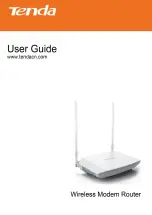
Chapter 4
| Wireless Settings
Radio Settings
– 45 –
same TKIP packet encryption and key management as WPA in the
enterprise, providing a robust and manageable alternative for small
networks.
■
Encryption
— Data encryption uses one of the following methods:
■
CCMP (AES)
— AES-CCMP is used as the multicast encryption
cipher. AES-CCMP is the standard encryption cipher required for
WPA2. (This is the default setting.)
■
Auto: TKIP + CCMP (AES)
— The encryption method used by the
client is discovered by the access point.
■
Key
— WPA is used to encrypt data transmitted between wireless clients
and the VAP. WPA uses static shared keys (fixed-length hexadecimal or
alphanumeric strings) that are manually distributed to all clients that
want to use the network.
String length must be 8 to 63 ASCII characters (letters and numbers).
No special characters are allowed.
■
WPA2-PSK
— Clients using WPA2 with a Pre-shared Key are accepted for
authentication.
WPA was introduced as an interim solution for the vulnerability of WEP
pending the ratification of the IEEE 802.11i wireless security standard. In
effect, the WPA security features are a subset of the 802.11i standard.
WPA2 includes the now ratified 802.11i standard, but also offers backward
compatibility with WPA. Therefore, WPA2 includes the same 802.1X and
PSK modes of operation and support for TKIP encryption.
Refer to WPA-PSK for a description of encryption methods and the key.
■
WPA-EAP
— WPA employs a combination of several technologies to
provide an enhanced security solution for 802.11 wireless networks. A
RADIUS server is used for authentication, and can also be used for
accounting.
Refer to WPA-PSK for a description of encryption methods.
■
RADIUS Settings
— A RADIUS server must be specified for the access
point to implement IEEE 802.1X network access control and Wi-Fi Protected
Access (WPA) wireless security.
In addition, you can configure a RADIUS Accounting server to receive user-
session accounting information from the access point. RADIUS Accounting
can be used to provide valuable information on user activity in the network.
Note:
This guide assumes that you have already configured RADIUS server(s) to
support the access point. Configuration of RADIUS server software is beyond the
Summary of Contents for EAP101
Page 1: ...User Manual www edge core com EAP101 EAP102 Software Release 11 1 1...
Page 2: ...User Manual EAP101 EAP102 Cloud Enabled Enterprise Access Point E042021 CS R01...
Page 9: ...9 Tables Table 1 Troubleshooting Chart 60...
Page 27: ...Chapter 2 Status Information Network Status 27 Figure 14 Active DHCP Leases and the ARP Table...
Page 62: ......
















































